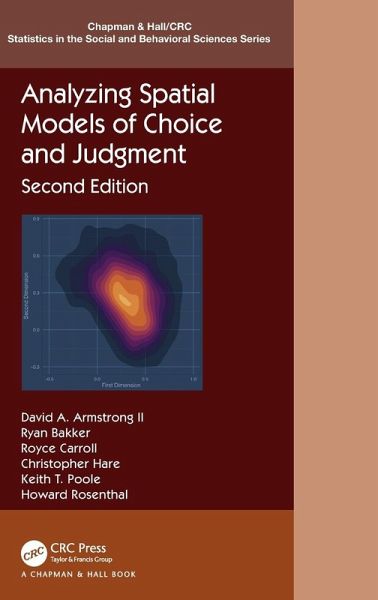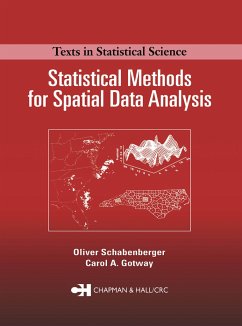Analyzing Spatial Models of Choice and Judgment
Versandkostenfrei!
Versandfertig in 1-2 Wochen
Weitere Ausgaben:

PAYBACK Punkte
86 °P sammeln!





How to apply spatial models using R to a wide range of data used in political science. Models are similar to multidimensional scaling models long used in Psychology and MDS models overage. Aimed at graduate students and researchers with basic knowledge of R, a "how to." In second edition, chapters updated to reflect these new R packages.
Dave Armstrong (http://quantoid.net) is Canada Research Chair in Political Methodology and Associate Professor of Political Science at Western University in Ontario, Canada. He received a Ph.D. in Government and Politics from the University of Maryland in 2009 and was a post-doctoral fellow in the Department of Politics and Nuffield College at the University of Oxford. His research interests revolve around measurement and the relationship between Democracy and state repressive action. His research has been published in the American Political Science Review, the American Journal of Political Science, the American Sociological Review and the R Journal among others. Dave is an active R user and maintainer of a number of packages. DAMisc has a number of functions that ease interpretation and presentation of GLMs. Ryan Bakker is Reader in Comparative Politics at the University of Essex. He received his Ph.D. in Political Science from the University of North Carolina at Chapel Hill in 2007. His research and teaching interests include applied Bayesian modeling, measurement, Western European politics, and EU elections and political parties. He is a principal investigator for the Chapel Hill Expert Survey (CHES), which measures political party positions on a variety of policy-specific issues in the European Union. His work has appeared in Political Analysis, Electoral Studies, European Union Politics, and Party Politics. Royce Carroll is Professor in Comparative Politics at the University of Essex, where he teaches graduate and undergraduate courses on comparative politics and American politics. He received his Ph.D. in Political Science at the University of California, San Diego in 2007. In addition to political methodology, his research focuses on comparative politics of legislatures, coalitions and political parties, as well as measurement of ideology. Carroll is also Director of the Essex Summer School in Social Science Data Analysis. Keith T. Poole is Philip H. Alston Jr. Distinguished Professor, Department of Political Science, University of Georgia. He received his Ph.D. in Political Science from the University of Rochester in 1978. His research interests include methodology, political-economic history of American institutions, economic growth and entrepreneurship, and the political-economic history of railroads. He is the author or coauthor of over 50 articles as well as the author of multiple books. He was a Fellow of the Center for Advanced Study in Behavioral Sciences 2003-2004 and was elected to the American Academy of Arts and Sciences in 2006. Howard Rosenthal is Professor of Politics at NYU and Roger Williams Straus Professor of Social Sciences, Emeritus, at Princeton. Rosenthal's coauthored books include Political Bubbles: Financial Crises and the Failure of American Democracy, Polarized America: The Dance of Ideology and Unequal Riches, Ideology and Congress, and Prediction Analysis of Cross Classifications. He has coedited "What Do We Owe Each Other?" and "Credit Markets for the Poor." Rosenthal is a member of the American Academy of Arts and Sciences. He has been a Fellow of the Center for Advanced Study in Behavioral Sciences and a Visiting Scholar at the Russell Sage Foundation.
Produktdetails
- Verlag: Chapman and Hall/CRC
- 2. Auflage
- Seitenzahl: 320
- Erscheinungstermin: 17. November 2020
- Englisch
- Abmessung: 240mm x 161mm x 22mm
- Gewicht: 646g
- ISBN-13: 9781138715332
- ISBN-10: 1138715336
- Artikelnr.: 60013903
Herstellerkennzeichnung
Libri GmbH
Europaallee 1
36244 Bad Hersfeld
gpsr@libri.de
"This book will have broad appeal across the social sciences, but especially in political science and psychology. An obvious audience is scholars doing work in attitudinal scaling, or psychometrics. However, the application of spatial models of the sort addressed in this text is certainly not limited to survey data or other types of data for which people are the units of analysis. These methods can be used to assess and describe the structure of relationships between variables or units wherever such relationships can be conceptualized as distances in some abstract space. I expect that this book will be used mostly as a reference guide, but only because courses in spatial models of this sort are (unfortunately) fairly limited. However, more
Mehr anzeigen
advanced courses in multivariate analysis, latent variable modeling, dimensional analysis, and measurement across the social sciences would likely find this text extremely useful. (Adam Enders, University of Louisville)
"This book provides excellent coverage of spatial models of choice and judgment...Overall the manuscript is technically correct and clearly written. The biggest strength of the book is the deliberately informal and applied nature of the approach of the book, where both code and output are shown. This makes it very easy for researchers to quickly get these models running on their own data quickly." (James Lo, USC)
"I find the manuscript technically sound, clearly written, and at an appropriate level of difficulty for quantitative social scientists. It has several strengths. First, it is a comprehensive and up-to-date survey of spatial models for scaling preferential and perceptual data (including dyadic data measuring similarities/distances). Second, it is replete with interesting examples from political science, which greatly increases the readability of the material. Third, by including many chunks of R code for data analysis and visualization, it greatly reduces barriers to implementing these methods for practitioners." (Xiang Zhou, Harvard University)
"This book provides excellent coverage of spatial models of choice and judgment...Overall the manuscript is technically correct and clearly written. The biggest strength of the book is the deliberately informal and applied nature of the approach of the book, where both code and output are shown. This makes it very easy for researchers to quickly get these models running on their own data quickly." (James Lo, USC)
"I find the manuscript technically sound, clearly written, and at an appropriate level of difficulty for quantitative social scientists. It has several strengths. First, it is a comprehensive and up-to-date survey of spatial models for scaling preferential and perceptual data (including dyadic data measuring similarities/distances). Second, it is replete with interesting examples from political science, which greatly increases the readability of the material. Third, by including many chunks of R code for data analysis and visualization, it greatly reduces barriers to implementing these methods for practitioners." (Xiang Zhou, Harvard University)
Schließen
Für dieses Produkt wurde noch keine Bewertung abgegeben. Wir würden uns sehr freuen, wenn du die erste Bewertung schreibst!
Eine Bewertung schreiben
Eine Bewertung schreiben
Andere Kunden interessierten sich für














